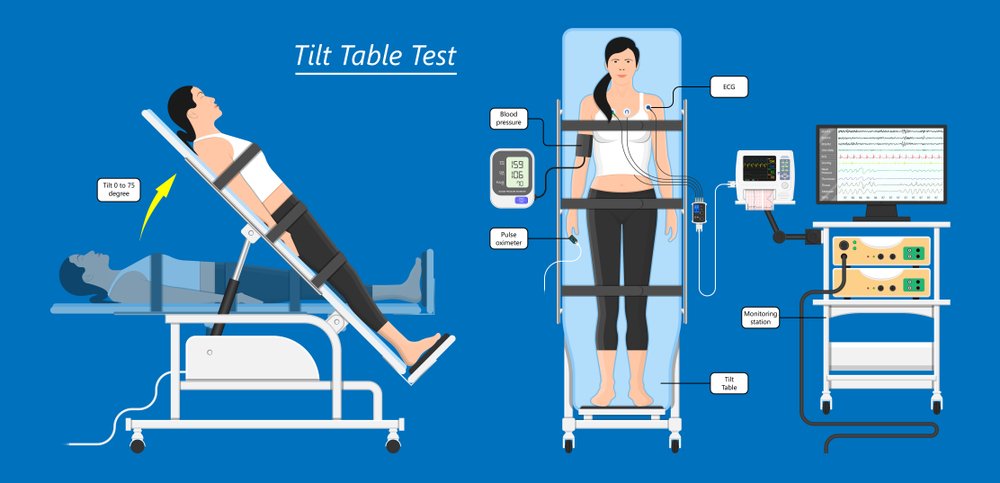Tilt table test in Türkiye
Why a tilt table test?
The tilt table test is recommended in Türkiye for patients suspected of having certain medical conditions, including:
Hypotension/fainting reflex
Doctors also call this condition the fainting reflex or autonomic dysfunction. It causes a person’s heart rate to slow instead of faster when standing, which prevents blood from pooling in the legs and arms. As a result, the person may feel faint.

Neurologically mediated syncope
A person with this syndrome experiences symptoms such as nausea, dizziness, and pale skin, followed by loss of consciousness.
Orthostatic tachycardia syndrome
This disorder occurs when a person’s position changes to a standing position suddenly. Doctors associate orthostatic tachycardia with an increase in heart rate of up to 30 beats, and feeling faint within 10 minutes of standing. Women between the ages of 15 and 50 are more likely to develop this syndrome.
The tilt table test simulates the effect of standing in a medically controlled environment, so that the doctor can see how the patient’s body responds to the effects of a position change.
Side effects
The main purpose of the tilt table test is to inform the doctor directly about the symptoms that the patient feels directly when the position changes, and the patient may not feel well during the procedure and may experience symptoms such as dizziness, fainting or severe nausea.
What are the procedural steps for the tilt table test?
- Follow advice about meal times
The patient may be asked not to eat two to eight hours before the procedure, since some people feel nauseous when moving from a sitting to standing position and this helps reduce the chances of nausea.
- Checking the medications the patient is taking
The doctor makes sure of the medications the patient is taking, and recommendations are made regarding possible medications to be taken the night before the test or on the morning of the test, and it is best to have a companion for the patient to help get him home after completing the test.
What happens during a tilt table test?
- The patient lies on a special table that has the ability to adjust its tilt angle by the operator. Where a specialist connects various monitoring devices to the patient’s body, such as a blood pressure monitor . and an electrocardiogram (ECG) . and an oxygen saturation monitor. An intravenous line may be opened in the arm to introduce the drugs into the patient’s body if necessary.
- He starts by tilting or moving the table so that the patient’s head is raised by 30 degrees and then checks the patient’s vital signs.
- The table continues to be tilted by 60 degrees or more, keeping the person upright. Blood pressure, heart rate and oxygen levels are measured continuously to detect if there are any changes.
- If at any time your blood pressure drops too low or you feel faint the table should be returned to the starting position. This helps the patient feel better.
- If a patient has no change in their vital signs and still feels fine after the table has moved, they may proceed to the second part of the test. Patients who develop symptoms do not need to progress to the second part of the test to show how their vital signs have changed.
- The patient is given isoproterenol (Isopril) to speed up the heartbeat. This effect is similar to that of a physical stress test.
- The test continues by increasing the angle to 60 degrees and the patient is likely to remain at this height for about 15 minutes to determine if they have a reaction to the change in position.
The test usually takes about an hour and a half if the patient has no changes in vital signs, and stops the test if the patient’s vital signs change or he or she does not feel well during the course.
post-test stage
The patient is transferred to another bed if he feels faint during the test or after it ends. The patient can stay under medical care for 30-60 minutes. He may be given anti-nausea drugs if he feels that way. Then the patient can leave the medical facility and he can drive a car, but in some cases he may The patient remains under night observation.
Tilt table test results:
What does a negative result mean?
The test is considered negative when there is no reaction by the patient’s body to the tilt table test, although it is possible that there is an undisclosed medical condition, and this is followed by other tests such as the installation of a Holter monitor to monitor the heart rate over the time .
What does a positive result mean?
The test is considered positive when there is a reaction by the patient’s body to the tilted table test, such as a change in blood pressure, a slowdown or acceleration in the heartbeat, and then some recommendations are made and other additional tests can be performed.
For example, if the heart rate slows, additional heart screening tests are recommended. He or she may prescribe a medicine called midodrine to prevent low blood pressure.
If the heart rate accelerates, medications such as fludrocortisone, indomethacin, or dihydroergotamine are prescribed to reduce the chance of a reaction.
Tilt table test in Türkiye:
The medical staff of surgical teams, doctors and consultants in REHABTÜRK can provide the best treatment options and free consultations – by striving to keep abreast of the latest medical technologies and methods.

